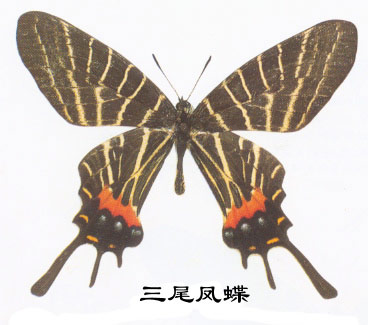Alias of three-tailed swallowtail butterfly: Chinese brown swallowtail butterfly, three-tailed brown swallowtail butterfly, three-tailed brown silk butterfly.
Wingspan is 86~92mm. The body is black with white hairs on the belly. Wings black. There are 8 transverse bands on the forewing, from the 1st, 2nd, 4th, and 8th bands from the base to the trailing edge, the 6th and 7th bands merge in the middle to the rear edge, but the upper half of the 7th band is not very obvious. There are 3 to 4 oblique transverse bands on the upper half of the hind wing, one from the base to the middle chamber, just parallel to the Cu2 vein, and a red horizontal spot near the hip angle; there are 3 blue spots below the red spot, and 4 to 4 on the outer edge. 5 spots, some of which are crescent-shaped; 3 caudal processes. The veins and interveinal lines on the back of the wing are very clear, and the rest are similar to the front.

Host: Aristolochia moupinensis Franch of the Aristolochiaceae family.
Biology: There is one generation per year. Adults appear in May and live in high mountain areas above 2000m above sea level.
Distribution: Gansu, Shaanxi, Sichuan, Yunnan, Tibet and other provinces, endemic to China, one of the rare butterflies, and a national second-level protected wild animal. "Threatened World Papilio" is rated R (very few individuals).
This species is very similar to the two-tailed swallowtail butterfly (Bh.mansfieldi). The difference is that this species has 8 horizontal bands on the upper half of the forewing, while the two-tailed swallowtail butterfly has 7 horizontal bands. The hind wings of this species have 3 tail processes and no finger-shaped processes; the two-tailed swallowtail butterfly has 2 tail processes and 1 finger-shaped process.
[Protection Significance and Measures] The cause of the endangered species is unknown, but greedy collection for trade is undoubtedly a serious threat. This species is a rare species in the world and is therefore listed as a protected species. It is recommended that its habitat be established as a nature reserve, and capture and random collection are strictly prohibited; basic research on ecology and biology should be carried out.
Distributed in Shaanxi, Henan, Hubei, Zhejiang, and Taiwan. Distributed abroad in Japan.
animal tags:
We created this article in conjunction with AI technology, then made sure it was fact-checked and edited by a Animals Top editor.